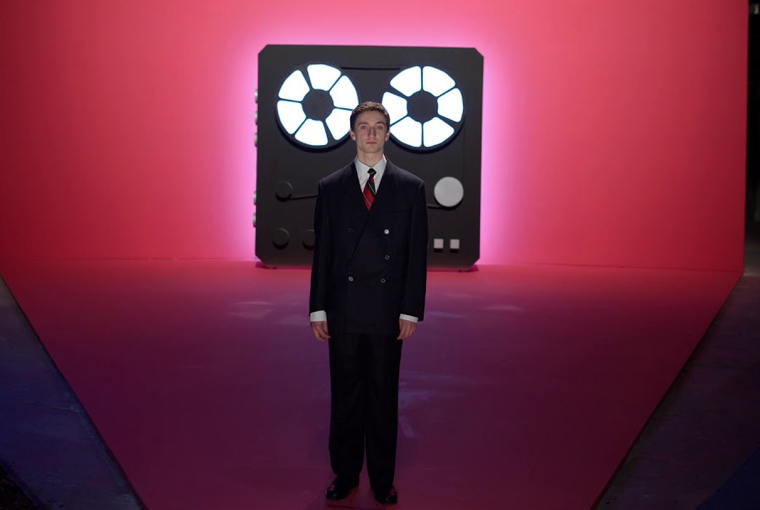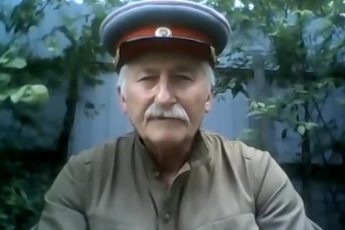Writing on the Wall
Radu Jude’s Uppercase Print (Tipografic majuscul, 2020)
Vol. 103 (March 2020) by Zoe Aiano
With his two most recent films, Uppercase Print and The Exit of the Trains (released simultaneously), Radu Jude continues to charge ahead in pursuit of the two missions that have come to define his career: to make Romania face up to the unpalatable sides of its past, and to explore the innovative use of archive materials in documentary. Of the two, however, the former is by far the less demanding of its audiences, despite coming in at an inflated 130 minutes. The key difference is not only the harshness of the subject matter (The Exit of the Trains gives names and faces to the victims of a horrific pogrom of Jewish men during World War Two) but also the playfulness of the approach. This isn’t to diminish the seriousness of the core topic of Uppercase Print – namely insidious state surveillance of citizens and the manipulation of language and image to perpetuate official ideology – which is, unfortunately, ever more relevant in contemporary society. Nevertheless, while in The Exit of the Trains Jude adheres rigidly to the tenets of brutal simplicity, in Uppercase Print he allows himself the indulgence of humor.
The uppercase print in question refers to a series of subversive texts written in chalk on a fence in the town of Botoşani in the early 1980s, resulting in a bizarrely thorough and intense investigation by the Securitatesecret police forces. Jude’s film builds on the work of Gianina Cărbunariu, who first researched the case and turned the transcripts into the script for a documentary theater piece. As such, the skeleton of the film consists of actors reciting the actual words of the figures involved, gradually piecing the story together. Each character says their piece directly to the camera, in symmetrically composed shots with sparse sets, against pointedly synthetic backgrounds dominated by garish colors and neon lighting. In keeping with the source of the texts, the deliveries are as artificial and stilted as the standardized bureaucratic language being used.
At the beginning, the whole situation is laughable. The efforts of the investigators are massively disproportionate and yet they remain totally hapless, as they begin analyzing thousands of writing samples in an attempt to identify the subversive vandal, and deploy dozens of hidden agents to keep guard over the scene of the crime. Equally risible are the various local workers who feel duty-bound to report their sightings of the graffiti, revealing the extent of the paranoia and the desperation to disassociate from any deviation from the official party line. Even the writings themselves are hard to take seriously. Largely addressing issues such as the food shortages in Romania at the time and raising awareness of the growing Solidarity movement in Poland, they are very on-point in terms of the message. However, they are often long-winded and, as such, fail to pack any real punch in terms of the delivery.
The punchline to this build-up comes with the revelation of the culprit, who turns out to be Mugur Călinescu, a teenager inspired by illicitly listening to broadcasts from Radio Free Europe (Mugur Călinescu is played by Șerban Lazarovici, who studies at the same high school Mugur himself attended in real life). This is also the point where the joke starts to seem less amusing. The focus shifts from mocking a state that is so insecure that it deems it necessary to launch a full-scale investigation over some chalk scribbles (and so inept that it barely manages to catch the perpetrator even there) to detailing the liberties this same state was willing to take to infiltrate and dominate its citizens. After Mugur is finally detected, agents proceed to bug his home to record the resulting arguments with his mother (played by Ioana Iacob, who previously worked with Jude on I Don’t Care if We Go Down in History as Barbarians) and father (Şerban Pavlu, also a recurring figure in a lot of Jude’s work). All of Mugur’s schoolmates are also brought in for questioning and monitored, as it becomes increasingly clear that Mugur will stay under close surveillance for the rest of his life. Indeed, despite his attempts to reform and conform, Mugur ends up meeting an early death in suspicious circumstances.
In parallel to this, the unfurling saga is continually interrupted by excerpts from Romanian television and film from the same period, i.e. 1981. The nature of these clips varies from newsreel and reportage to elaborate folk performances and advertising, with patriotic songs and dance routines that form the shape of the country, as well as the theatrics of Ceaușescu’s public appearances. Most of them are entertainingly kitsch. All of them, watching with hindsight, are self-evidently propagandistic. Through the juxtaposition of the two contrasting documentary languages, Jude is not only adding dynamism and dramaturgical rhythm, but most crucially establishing a dichotomy between Romanian reality as it was presented and Romanian reality as it was lived. In essence, Mugur’s greatest crime was to dare to contradict the patent falsity of this official representation of the nation. As retribution for this act of negation, the state then does everything in its power to take control of his own individual narrative. While the film as a whole could stand to be trimmed of some excess, the concept itself is nevertheless intriguing, engaging and provocative. In particular, the recontextualization of commonplace visual culture is not only innovative and effective, but hammers home the importance of questioning the sources and motivations of those producing the media, and what these images may be hiding in plain sight.




Leave a Comment